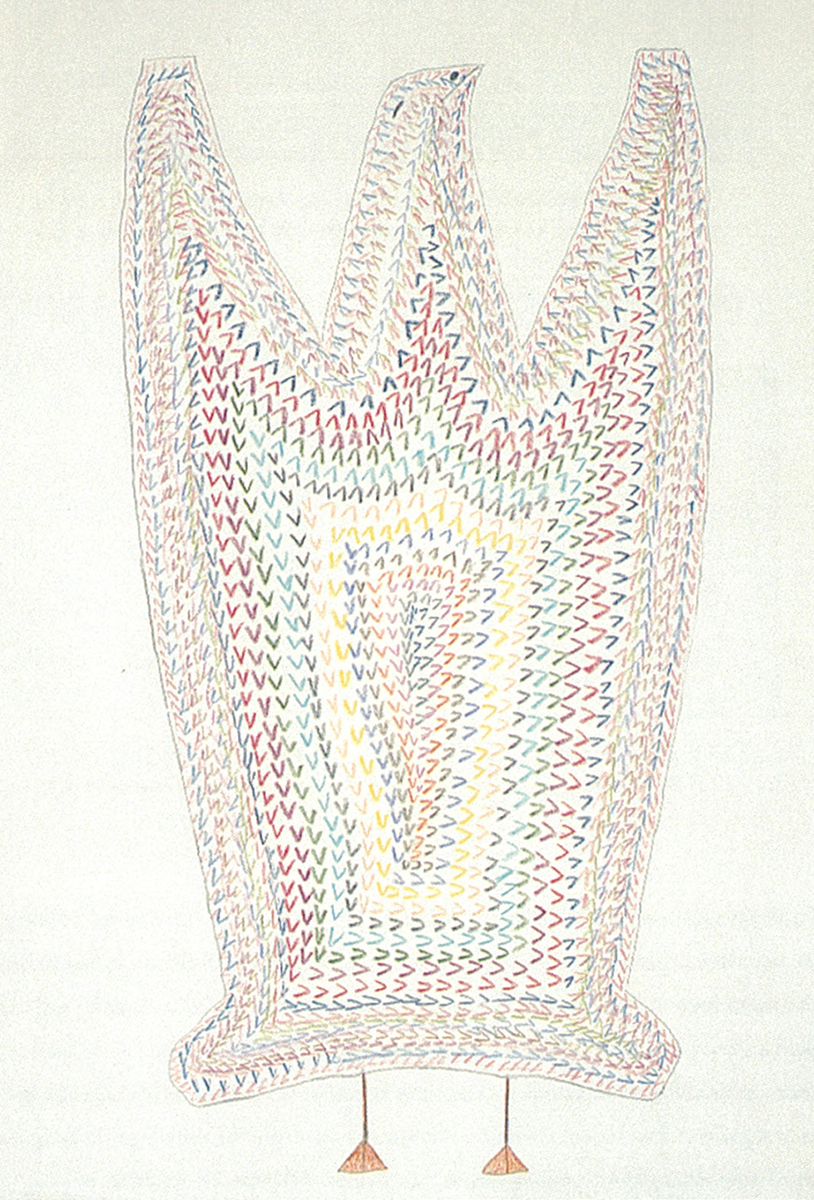
BIRD, 1998, coloured pencil, 26 x 20 in. “The bird is covered in stitches like patterns on clothing.”
Exhibition opened November 14, 1998
Our perception of an artist is that technique can be learned but talent is latent, lying dormant until stirred by opportunity. Sheojuk’s opportunity came late in life. She did not begin to draw until she was in her mid-60’s, as the result of a chance occurrence. Barely six months later, the first of her distinctive images appeared on the cover of the 1994 Cape Dorset annual graphics collection catalogue. She is known primarily because of her prints, but nowhere is her genius more apparent than in the original drawings. In preparation for this first solo exhibition, Patricia Feheley and Sheojuk Etidlooie met in Cape Dorset in the summer of 1998. In the course of several interviews about Sheokjuk’s work, they discussed these drawings. The titles and descriptions included here are a result of these conversations with the artist.
Sheojuk Etidlooie was born in 1929 in Akkuatuloulavik, an outpost camp near Cape Dorset on southern Baffin Island. Growing up in this environment gave her not only a knowledge of the ‘old ways’, but also a familiarity with the land, the animals and birds. She settled in Arctic Bay with her husband and lived there for many years, eventually moving to Iqaluit. In the early 1990s, she returned to Cape Dorset where she now lives in the Elders Residence. She had always admired the artists in Cape Dorset, especially those who could draw. During the church Christmas games in 1993, she drew a picture of a kudlik, the traditional seal oil lamp. This drawing won first prize, awarded by respected artists Kananginak and Paulassie Pootoogook. Encouraged by this success, and under the direction and support of the West Baffin Eskimo Cooperative, Sheojuk began drawing regularly, gaining confidence as the time passed. Her drawings were first made into prints in 1994. Since that time, she has been included in each spring and fall release. This year, almost one half of the prints in the 1998 Cape Dorset annual graphics collection are by Sheojuk. This phenomenal success is remarkable for an emerging artist. It is in her original drawings rather than her prints that the essence of her genius is found. This exhibition traces Sheojuk’s artistic development from her early drawings to the most recent. She creates bold compositions featuring single floating forms. Even when action is suggested, these images are somehow static, like iconic emblems of traditional Inuit like to be shuffled and recombined in her personal visual language. (See Figure 17). She often explores themes by creating a series of drawings—finding various ways of presenting the same fundamental image. Perhaps as an echo of her lifelong experience with sewing, she works frequently with tracings, transferring the outlines of her earlier drawings or prints onto the paper. Each is then given an entirely new character through colour variation, surface embellishment and subtle modification of the original design. Sheojuk’s drawings of giants provide a good example of the serial nature of much of her work. The hands of the giant in one drawing are transformed into claws resembling fishhooks which, the artist notes, are to be used for climbing rocks. (See Figure 15). In one distinctive example, the giant is covered in what appears to be multicolored stitches
as if the image had been perceived as a tapestry. Remarkable variation within a series is particularly evident in Sheojuk’s studies of the narwhal. The tusk of the narwhal appears in some drawings as a stylized linear symbol and in others as a realistic spiral to indicate three-dimensional form. In some the whale is seen from above, in others the artist distorts perspective by showing both sides of the whale at the same time. (See Figure 11). Studies of birds, through their translation into prints, have become the most recognizable of Sheojuk’s recurring explorations of a single subject. Her signature owl, presented singly or in more complex compositions, is given individual personality through variations in colour and detail. (See Figure 5). A bird with raised wings, through a series of increasing abstractions, becomes a wonderfully intriguing and contemporary image. (See Figure 8). Some subjects recur, others appear in isolation. Despite their diversity, these works from the past five years share an overall continuity because of Sheojuk’s delightful and original style. Feheley Fine Arts is proud to present the first solo exhibition of drawings by this significant new talent.
To view available artworks by the artist, click here.
